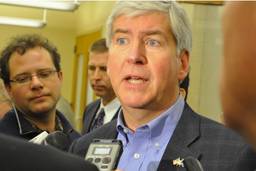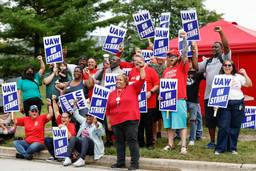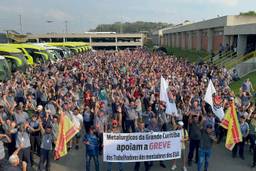This is the latest installment in a series on getting out the vote with the AFL-CIO in Toledo, Ohio.
Twenty-two volunteers representing eight unions show up for this morning’s weekly staff meeting. Most are middle-aged or older. The postal unions are particularly well represented today, along with steel, the electrical workers, machinists, public employees and teachers.
Getting into the Teamsters Local 20 building requires navigating a maze of yellow construction tape and orange cones set up to keep visitors from tracking in tar and wet blacktop from the newly paved parking lot. Outside, a contractor lays down diagonally striped parking spaces in a machine that looks like a beaten up Zamboni. The plan is to have the parking lot shipshape for Thursday evening’s rally, which will feature Teamster President Jim Hoffa and AFSCME President Lee Saunders. Some predict 1,000 or more union members will show up, maybe even double that number.
Local trade unionists say that Toledo’s labor movement is doing its part to turn out massive vote numbers – a not so subtle jab at their Rock and Roll Hall of Fame-boasting cousins to the east. A local staffer for one of the international unions tells me that if Cleveland’s labor movement had put as much oomph and effort into mobilizing voters as Toledo had in 2010, Ted Strickland would still be Governor. How much of this is bullshit or just plain familial rivalry I cannot say, but I like the swagger.
As the meeting begins, we’re seated in metal folding chairs sardined around what looks like a pontoon bridge of several long collapsible tables as the 20-somethings who are running the show pass out new talking points and flyers. There’s a pep talk that nicely balances enthusiasm, optimism and praise with the organizer’s grim admonition that no matter how many doors you’ve knocked, you still haven’t knocked on enough, and no matter how far out front your candidate is running, this is no time to let up.
In fact, the number of phone calls and house visits Toledo’s volunteers completed this past weekend alone advanced well into five-digit territory, setting a record for the campaign thus far. Two postal workers, Herb and Pat, hold the unofficial record for the most home visits completed during a single shift – they are letter carriers, after all – at 194, trailed closely by AFSCME and AFT members Curtis and Bill, who hit 149 one day and 135 the next. As the mostly local band of volunteers takes five for a little well-deserved self-applause, I wonder what their counterparts in Cleveland are being told this morning.
For this afternoon’s canvas I’m paired with Dee, an administrative support professional at the headquarters of an international union in Washington, DC. The packet we’re assigned consists of 49 households in a community six miles northwest of Toledo. The walk lists identify the addresses we are supposed to visit, along with the names and other relevant information, such as party registration, voting history, demographics and union affiliation. We split the packet (I take the even-numbered streets, Dee takes the odd), then load the first address into my Garmin. Twenty minutes later we’re in a residential neighborhood bordered by massive storage tanks and refinery scaffolding interspersed by small fabrication and manufacturing plants. It’s the kind of industrial landscape I once disdained as ugly and aesthetically offensive, but for which I’ve since developed a more humble appreciation as more and more of the manufacturing economy gets offshored by the likes of the 1%-ers we’re campaigning against.
When I mention this change of heart, Dee says “I never thought those pipes and big metal tanks looked ugly. They make me wonder what they’re producing and what kind of jobs the people who work there have.”
Once we arrive, Dee and I split up, me to the evens, she to the odds. I approach a brick-and-white raised ranch deep inside a residential enclave just as the occupants pull into their driveway. They are a Haitian-American couple, the husband registered as an Independent, the wife as a Democrat. The walk list tells me that neither has a union affiliation. I indentify myself as a union volunteer working on the election campaign and ask if they are aware of ballot issue 2 and why its passage will help working families. The husband lets me go through my brief spiel as his wife lugs her share of the grocery bags into the house.
“So you say you’re with the union,” he asks. “Will the union give me back my job?”
He tells me he was laid off from an automobile plant, and he would like nothing more than his old job back. He knows, of course, that it wasn’t the union that fired him and that it’s not in the union’s purview to hire him, but he’s been pissed for a long time and the union’s as good a target as anyone. “Why should I vote for someone who won’t get my job back?”
I can explain that Obama threw the automobile a lifeline while Romney told it to drop dead, but he already knows that. The more he voices his anger and frustration, the clearer it becomes that he’s looking for someone who knows what it means to lose a livelihood to unseen forces and unfair competition, and it’s clearer still that he wants a champion who will fight for him–fight unflinchingly with his chin up and eyes blazing – and not just stand there and take it. This is about the disappointment and embarrassment he feels in Obama’s debate performance. “When you’ve got the facts, you don’t let the other guy get away with falsehoods. You hit back with facts, facts, facts,” he says, punching out each word. Clearly, this is someone who will never vote for Romney, never in a million years. “You’re the union,” he tells me, “you go tell Obama to fight.”
We part on good terms, and as I scan the walk list for my next address, I can’t help but hear a loud hearty laugh reaching out from the spot where I had just been standing. “Look,” comes a shout from the mailbox. He’s lifting up a color postcard plastered with Mitt Romney’s photo, held quizzically between the fingers the way you’d pinch the plastic bag into which you scoop your dog’s poop.

I hope you found this article important. Before you leave, I want to ask you to consider supporting our work with a donation. In These Times needs readers like you to help sustain our mission. We don’t depend on—or want—corporate advertising or deep-pocketed billionaires to fund our journalism. We’re supported by you, the reader, so we can focus on covering the issues that matter most to the progressive movement without fear or compromise.
Our work isn’t hidden behind a paywall because of people like you who support our journalism. We want to keep it that way. If you value the work we do and the movements we cover, please consider donating to In These Times.






